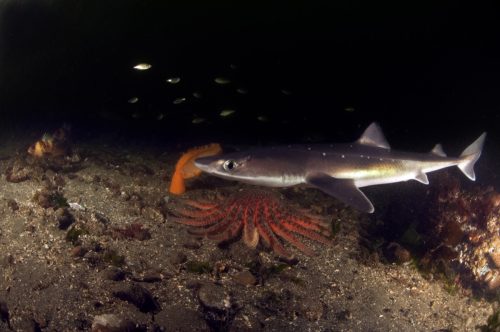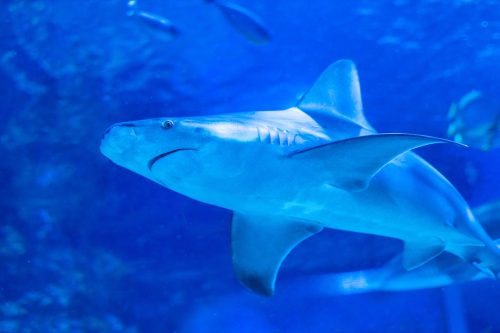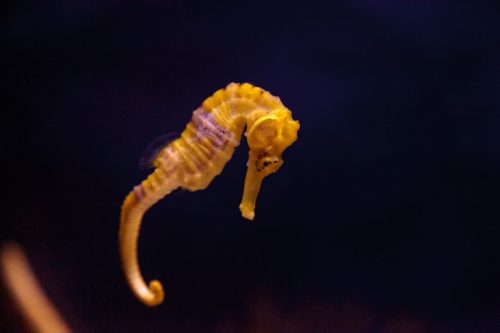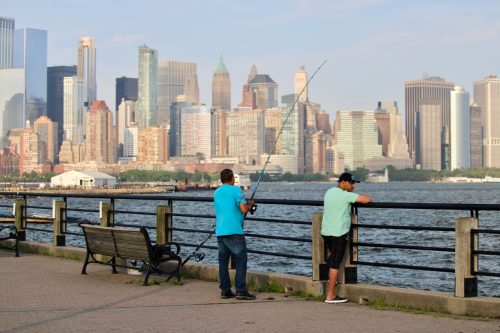Video Shows Man Catching Shark in NYC’s Hudson River
It was certainly the catch of the day.

New Yorkers usually associate Hudson River with muddy, greenish-brown water rather than with a vibrant habitat of many aquatic organisms (or maybe you remember Sully landing a plane there, the Miracle on the Hudson). Yet in a new video published on Reddit, you can see a man holding up a smooth dogfish shark, which he just caught fishing off a pier there. Comments under the video immediately flared up a discussion about the inhuman treatment of the fish by the angler, since the fisherman encourages passing people to touch, and even stroke, the unique scales covering the fish. Read on to learn more about exactly what happened next.

Most of the commenters expressed hope that the fish has returned back to the water. “Seriously that thing was out of the water upside down for way too long, poor thing was probably freaking out unable to breathe, and people just running their hands up and down it,” was one of comment. Another said: “This is so beyond moronic and cruel.” ”I want to see a man held underwater and all of the other sea animals gathered around to look at the upside down human gasping for air,” said another. Keep reading to learn more and see the video.

In the waters surrounding New York, you can meet many species of sharks. They differ in size, from 4 feet, such as dogfish sharks, up to 40 feet, such as the basking shark. The characteristics of sharks also vary greatly, as well as what they feed on or their way of hunting. These differences affect the type of environment they choose to live in. For more information about shark safety and fishing, visit Coastal Sharks.

However, the Coast Guard states that during their patrols dolphins are a much more common sight than sharks. Lt. Sean Reilly, supervising environmental conservation officer with the DEC, told Fox 5 “When I started 20-something years ago, we saw a dolphin on rare occasions.” In his opinion, “Now every time we go into the ocean, we seem to see multiple schools of dolphins.” “Most of the sharks are seen by people actually catching them because they are not up on the surface most of the time,” he adds.

Prohibited shark species found in New York State water reservoirs include Sandbar (“Brown”), Dusky, and Sand Tiger sharks. Large (non-dogfish) sharks that are caught from NYC shores are usually prohibited shark species. For a full list of all prohibited shark species, view Recreational Saltwater Fishing Regulations.

“Estuaries are incredibly diverse ecosystems, second only to rainforests. There are 70 different species that call the Hudson home,” Tina Walsh of the Hudson River Park River Project said to NBC New York. One of the most unexpected individuals is the Lined Seahorse. “A lot of times you think of a seahorse as more of a tropical fish but in fact the lion seahorse is a northern Atlantic species” stated Walsh. Other essential species living in the Huston are oysters. The Hudson River is now home to over 11 million newly-deposited oysters. Tidal wetlands of Hudson River also provide important habitat for diamondback terrapins, fiddler crabs, rails and killifish, river otters, turtles, bald eagles, and other raptors, marsh wrens and herons, crayfish and dragonflies, and blackbirds.

Before you go shark fishing on the Hudson River, remember that all New York anglers must apply for and carry the no-fee Recreational Marine Fishing Registry. To fish for sharks, tuna, billfishes, and swordfish in federal waters, anglers must apply for a federal Highly Migratory Species (HMS) Permit. For more specific information about the rules associated with the HMS permit, please review the HMS Compliance Guide for Recreational Fishing.

The Hudson River Park’s River Project conducts environmental education, scientific research, and urban habitat improvement to raise New Yorkers’ awareness of the ecological importance of the 400-acre Estuarine Park Sanctuary. The aim of the project is to protect and restore the ecosystem of the Hudson River waterway. As the Hudson River Park serves as an important habitat as well as a temporary residence for numerous fishes, birds, crustaceans, and insects, monitoring the way how these species use Hudson River, provides valued information about these populations.














